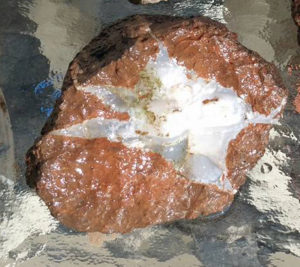That’s the question I was asking myself after a recent rock hounding trip for thunder eggs? The inner design of the rock reminded me of a Septarian Nodule, but these were supposed to be Thunder Eggs. What was the difference?
Wikipedia provided lots of technical information on each type of rock – sedimentary, etc. The simplest explanation was provided by http://www.desertusa.com/desert-prospecting/geode.html.
“A geode is a round rock which contains a hollow cavity lined with crystals. Rocks which are completely filled with small compact crystal formations such as agate, jasper or chalcedony are called nodules. The only difference between a geode and a nodule is that a geode has a hollow cavity, and a nodule is solid.”
First, let’s look at Septarian Nodules. They can be found in Morocco, Colorado and Alaska. What you’ll find at most Utah Rock and Gem Shows comes from Orderville, Utah. The centers of these Nodules display a bright yellow calcite that has a rich brown layer of siderite between the clcite and the gray exterior. It is fairly common to find a hollow cavity in Utah Septarians. These cavities can hold other minerals besides yellow calcite. Septarians from Orderville are popular cut in half and polished as they range in size from an inch to 3 feet.

Wikipedia states:
“In sedimentology and geology, a nodule is small, irregularly rounded knot, mass, or lump of a mineral or mineral aggregate that typically has a contrasting composition, such as a pyrite nodule in coal, a chertnodule in limestone, or a phosphorite nodule in marine shale, from the enclosing sediment or sedimentary rock.”
“A Thunder Egg is a nodule-like or geode-like geological structure with some adhering silicified host rock comprising the outer zone of the thunder egg. Thunder Eggs are usually composed of quartz, agate, opal, and/or visibly crystalline quartz. A common feature of thunder eggs is that the infilling material might not have concentrically formed layers. Often thunder eggs have both an outer zone that is concentric but the central material is layered as if they were sedimentary layers. The layers may have contrasting colors. “ http://www.mindat.org/min-31316.html
It gets very technical, but for my purposes I’ll remember it that Thunder Eggs are solid and filled with agate. Septarian Nodules are full of crystals. Unless they aren’t. Sigh!!!